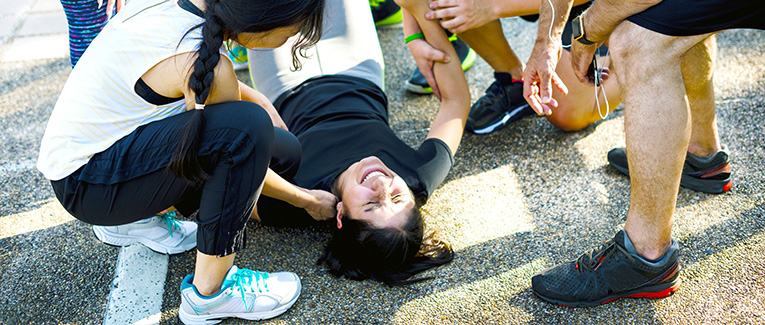
You see someone collapse on the road. What do you do? Your first instinct might be to dial 911. After all, calling 911 in the time of an emergency is almost a given.
However, not every medical emergency necessitates an ambulance. You should call 911 if the person is unresponsive and showing symptoms like trouble in breathing, chest pain, or signs of a stroke. There are many instances when dialing 911 may not even be a possibility. Your phone could run out of battery, or you might not get service. In some instances, you might be required to take urgent action before you can call 911.
Keep a well-stocked first-aid kit
Keep a first-aid kit in your home, vehicle, and your carryon bag. If you have a stock of medicines, bandages and disinfectants, you can take action and help the injured person.
You can buy a pre-made kit or build your own. Ensure that your kit has these items:
- A pair of nitrile or latex gloves and a CPR mask. You need to create a barrier between yourself and the injured person to prevent the transmission of diseases.
- Supplies for treating wounds and burns, such as sanitized tweezers and absorbent dressings.
- Shears, bandages, and tape to dress wounds, or create a tourniquet to control bleeding.
- Medicines like Aspirin, Ibuprofen (Advil), Tylenol, Imodium, Benadryl, and Antacid.
Download a first-aid app
Download something like the Red Cross First Aid app. The app is free, and you can watch step-by-step instructions and videos on how to handle a variety of medical emergencies. This will prepare you to take the appropriate action during an emergency.
The app also lets you monitor severe weather and emergency alerts in your town and other cities.
Guide the person who feels faint
If you or someone around you feels faint, you can instruct them to maintain consciousness. Ask them to lie down. If the person actually faints and falls, they risk sustaining a severe injury.
Ask them to try to squeeze their hands or legs together. This can raise their blood pressure and alleviate lightheadedness.
Administer aspirin if someone showing symptoms of a heart attack
The major symptoms of a heart attack are chest pain, jaw pain, shortness of breath, and nausea. If you see these symptoms and suspect a heart attack, make the person sit immediately and give them a 325mg dose of aspirin.
Ensure that they chew it and not swallow. Swallowing the pill increases its absorption time.
Perform CPR
If someone’s heart has stopped beating, that means that they’re going into cardiac arrest, and you need to start CPR immediately.
If you do not have the CPR mask, you can try hands-only CPR. Push down on the center of the chest, hard and fast. Aim to compress at least 2 inches down. You can get a metronome app on your phone that will keep the beat of 100 compressions per minute. You can visit https://www.redcross.org/take-a-class to take a class in CPR.
Control the bleeding
If someone has cut themselves badly, you need to immediately stop the bleeding. If you don’t have gloves, put a plastic bag between you and the cut, and try to assess exactly where the blood is coming from. You may have to remove the person’s clothing. Once you’ve located the wound, use the palm of your hand to apply heavy, direct pressure to it.
If this does not help the situation, place a tourniquet (or scarf or belt) 2 inches above the bleeding, and tighten it until it stops the bleeding.
Use the “five-and-five” approach if someone is choking
If you see someone choking, stand to their side (kneel down if it’s a child). Place one arm across the person’s chest and bend them over at the waist. Then use the heel of your hand to deliver five back blows between the person’s shoulder blades. After this, give 5 abdominal thrusts (the Heimlich maneuver).
Alternate between these blows and thrusts until the blockage is dislodged.
Don’t touch the injured person in case of electrocution
Your first instinct might be to grab and pull the person away from the source of electricity. Doing that will only result in you getting electrocuted as well. Turn off the power source, or move it away using a dry, non-conducting object made of cardboard, plastic, or wood.
If the person has become unresponsive, perform CPR. If there are burns, use a bandage to cover them. Don’t use a blanket or towel, because loose fibers can stick to the burns.
Attend to a person who’s having a seizure immediately
Seizures are very common. Most of them end in a few minutes. You should loosen any clothing that might be around the person’s neck, and lay the person down on the floor.
Do not restrain or put anything into the person’s mouth, as they can’t swallow their tongue. Do not try to stop their movements, either.
Stay with the person until the seizure ends and they’re completely awake. Then, make sure they get home safely.
Go to the ER for medical emergencies
If you’re driving to the hospital due to a medical emergency, head to the emergency room. ERs are open 24/7 and have adequate equipment to stabilize the patient. They are also required to provide treatment regardless of the patient’s ability to pay.
Urgent care on the other hand, although has shorter wait time, isn’t open 24/7. It doesn’t provide service to people who can’t pay, and you might not see a physician. You should go to an urgent care in case of less serious illnesses, such as a sprained ankle.
A medical emergency can be very scary, not only for the injured person, but also for you. It is important that you stay calm and understand your role.
Every second counts, so be prepared. Your actions can save someone else’s life.

